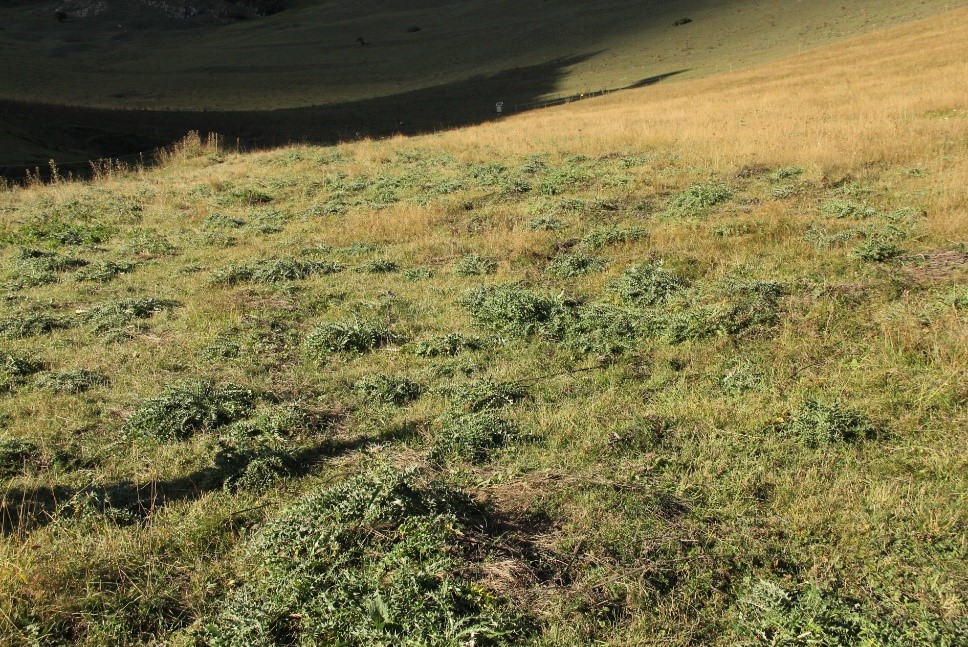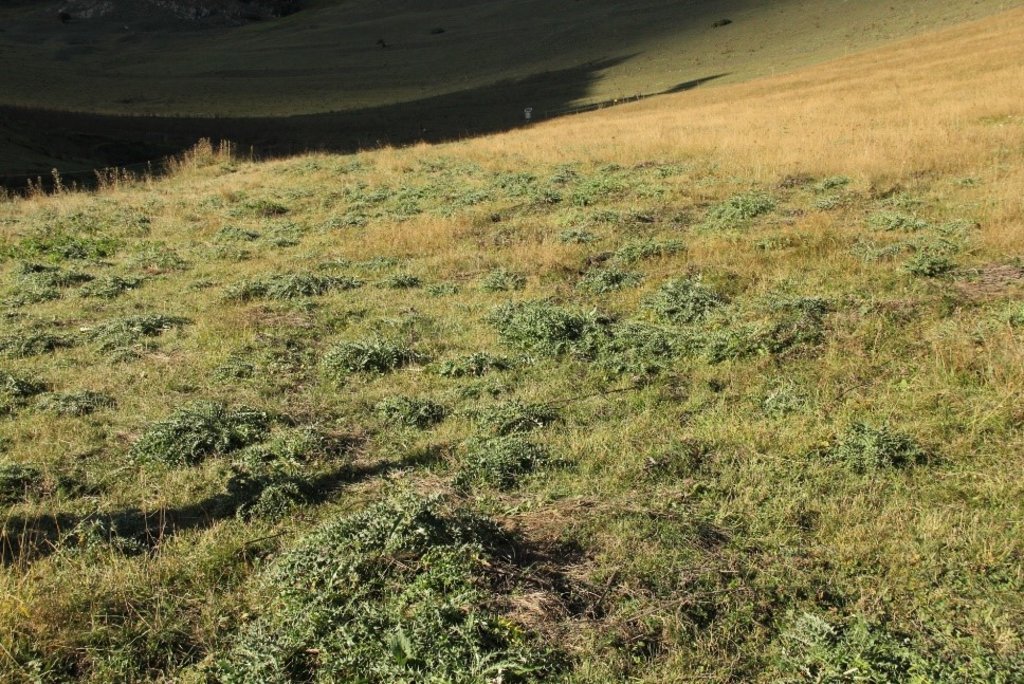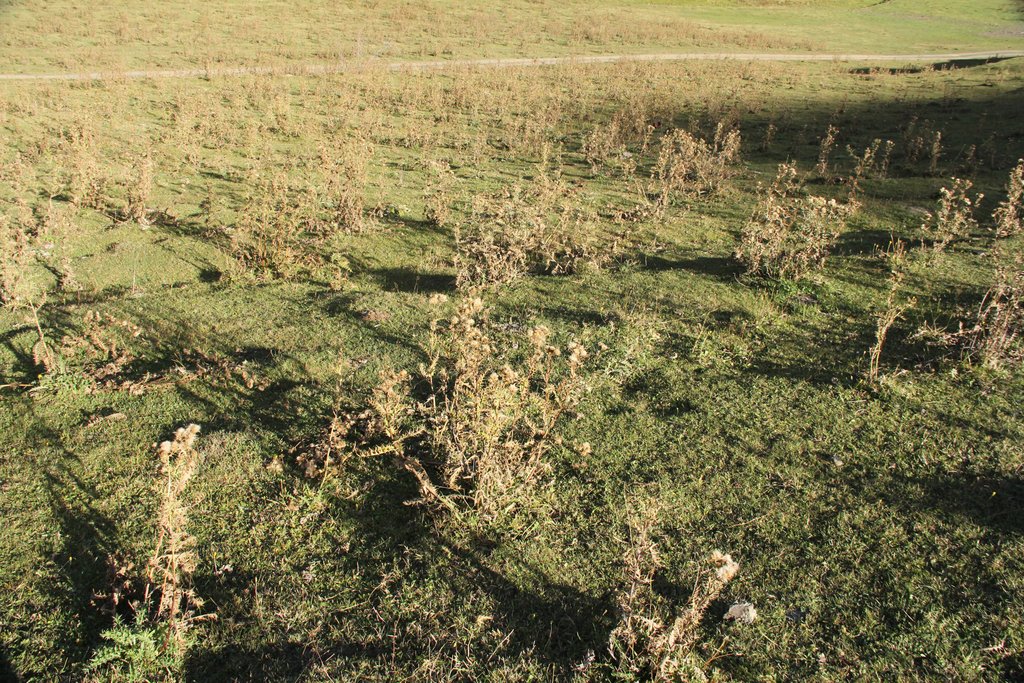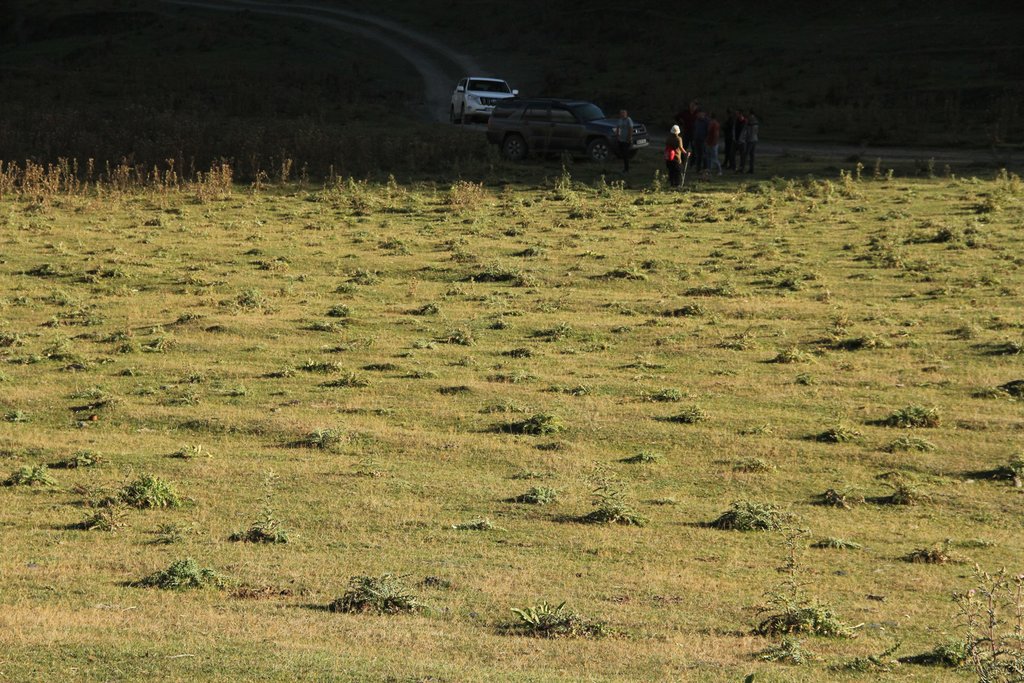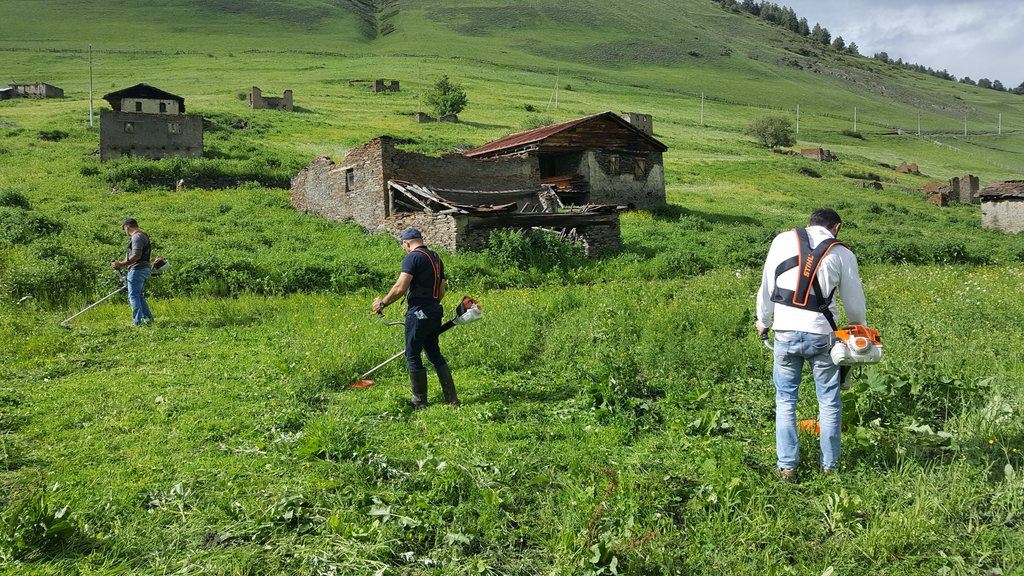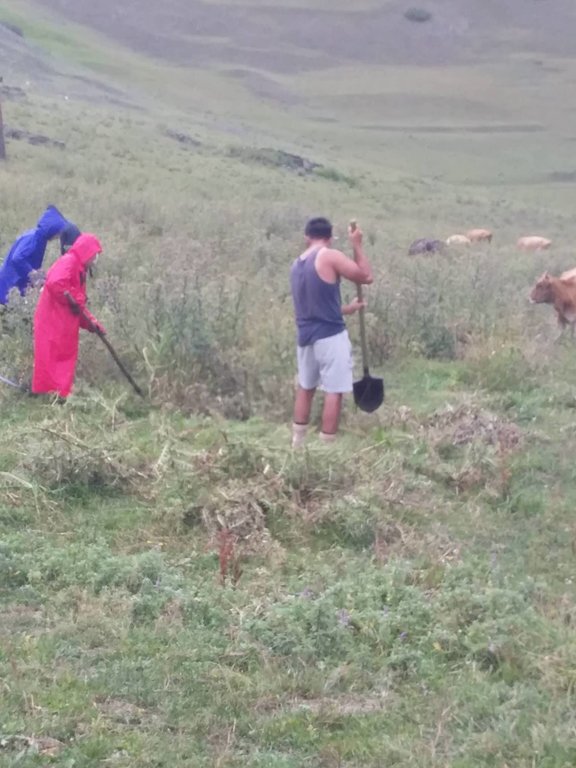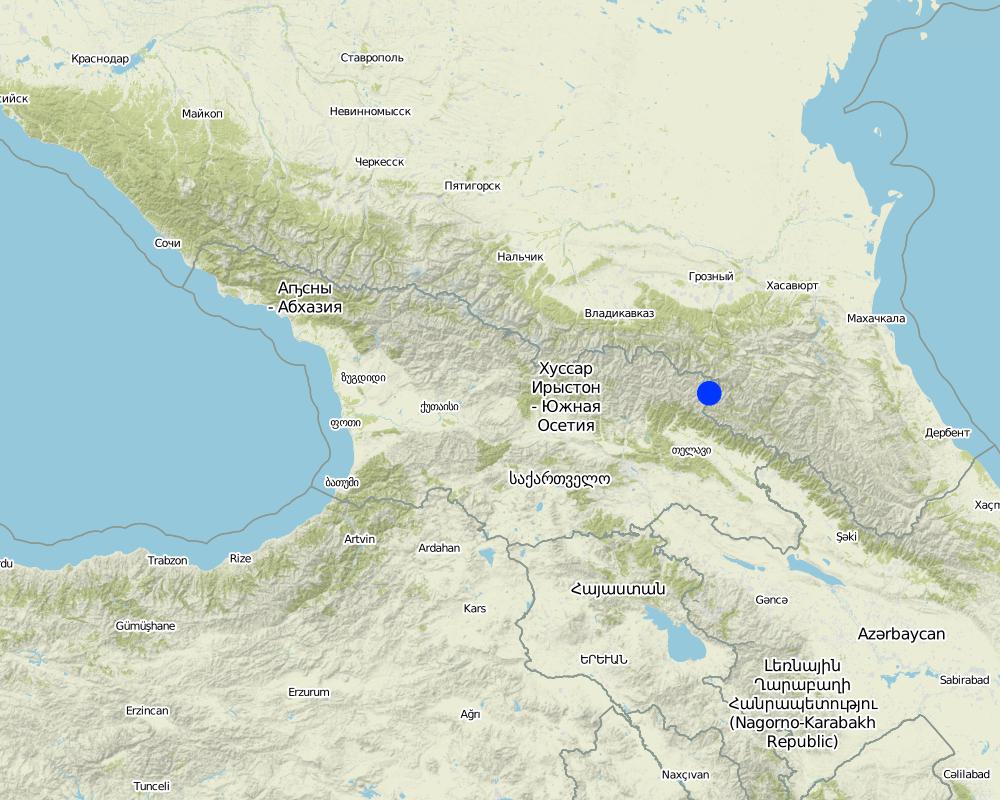Pasture-weed control by thistle cutting [จอร์เจีย]
- ผู้สร้างสรรค์:
- การอัพเดท:
- ผู้รวบรวม: Hanns Kirchmeir
- ผู้เรียบเรียง: Kety Tsereteli
- ผู้ตรวจสอบ: Ursula Gaemperli
technologies_4273 - จอร์เจีย
ดูส่วนย่อย
ขยายทั้งหมด ย่อทั้งหมด1. ข้อมูลทั่วไป
1.2 รายละเอียดที่ติดต่อได้ของผู้รวบรวมและองค์กรที่เกี่ยวข้องในการประเมินและการจัดเตรียมทำเอกสารของเทคโนโลยี
co-compiler:
ชื่อของโครงการซึ่งอำนวยความสะดวกในการทำเอกสารหรือการประเมินเทคโนโลยี (ถ้าเกี่ยวข้อง)
Applying Landscape and Sustainable Land Management (L-SLM) for mitigating land degradation and contributing to poverty reduction in rural area (L-SLM Project)ชื่อขององค์กรซึ่งอำนวยความสะดวกในการทำเอกสารหรือการประเมินเทคโนโลยี (ถ้าเกี่ยวข้อง)
Regional Environmental Centre for the Caucasus (REC Caucasus) - จอร์เจีย1.3 เงื่อนไขการใช้ข้อมูลที่ได้บันทึกผ่านทาง WOCAT
ผู้รวบรวมและวิทยากรหลักยอมรับเงื่อนไขเกี่ยวกับการใช้ข้อมูลที่ถูกบันทึกผ่านทาง WOCAT:
ใช่
1.4 การเปิดเผยเรื่องความยั่งยืนของเทคโนโลยีที่ได้อธิบายไว้
เทคโนโลยีที่ได้อธิบายไว้นี้เป็นปัญหาของความเสื่อมโทรมโทรมของที่ดินหรือไม่ จึงไม่ได้รับการยอมรับว่าเป็นเทคโนโลยีเพื่อการจัดการที่ดินอย่างยั่งยืน:
ไม่ใช่
แสดงความคิดเห็น:
The applied technology avoids the application of chemicals by mechanical weed removal.
1.5 Reference to Questionnaire(s) on SLM Approaches (documented using WOCAT)
2. การอธิบายลักษณะของเทคโนโลยี SLM
2.1 การอธิบายแบบสั้น ๆ ของเทคโนโลยี
คำจำกัดความของเทคโนโลยี:
Thistles invaded massively into village pasture land at 1800m elevation in the Caucasus. By cutting the thistles with a motor-cutter the cover of thistles have been reduced.
2.2 การอธิบายแบบละเอียดของเทคโนโลยี
คำอธิบาย:
The technology was applied in flat sub-alpine pasture land at an elevation of about 1800 m in the village of Shenako in the Tusheti Protected Landscape, Georgia. Precipitation is 750-900mm and mean annual temperature is 2-4°C. Thistles (Cirsium sp.) were invading especially in those sections of the pasture that are rich in nutrients and have medium soil water content. This site conditions can be found mainly at the valley bottom.
There are no big machines available in this mountain villages. So the removal was done by motor-cutters. In this particular case STIHL petrol brush cutters were used with a 3 blade bush knife.
The removal of the thistles, which were covering up to 20% of the pasture land will increase the productivity of valuable fodder grass and herbs. The thistles are growing up to 1m height and taking up significant amount of nutrients from the soil and are shading other grass and herbs in their neighborhood. Because of their spices they are not eaten by cows or sheep, while the grazing pressure is increasing on the remaining grass and herb species. This leads to positive selection of thistles and a permanent increase of the thistles number and biomass in comparison to the high quality fodder plants.
The thistles have been cut in mid-June/beginning of July just at the begin of blossom. At this stage, the thistles mobilized most of the nutrients from their root system and spent them in leaf and blossom biomass. By cutting the thistles at this time, the highest impact on the nutrient balance can be reached and no new seeds will be produced in this year. It was observed, that the thistles have been eaten by the livestock when it was cut and dried up.
The motor brush cutter increases significantly the speed of cutting the thistles compared to hand scythe. The thistle has a powerful root system and is re-sprouting from the roots within the same summer. So it is important to repeat the cutting 2-3 times a year and to continue several years until the amount of thistles is permanently reduced.
The reduction of thistles will give more space, nutrients and moisture to other fodder plants and increase the productivity of the pasture land.
The challenge is the coordination of the work load within the users of the community pasture land. It needs a (written) agreement to share the workload for pasture maintenance between the families according to their number of livestock.
2.3 รูปภาพของเทคโนโลยี
คำอธิบายภาพ:
The photos are showing the state of the pastures before and 2 months after the application of the technology.
2.4 วีดีโอของเทคโนโลยี
ความคิดเห็น/อธิบายสั้นๆ:
No video available
2.5 ประเทศภูมิภาค หรือสถานที่ตั้งที่เทคโนโลยีได้นำไปใช้และได้รับการครอบคลุมโดยการประเมินนี้
ประเทศ:
จอร์เจีย
ภูมิภาค/รัฐ/จังหวัด:
Kakheti
ข้อมูลจำเพาะเพิ่มเติมของสถานที่ตั้ง :
Shenako
ระบุการกระจายตัวของเทคโนโลยี:
- กระจายไปอย่างสม่ำเสมอในพื้นที่
If the Technology is evenly spread over an area, specify area covered (in km2):
0.02
If precise area is not known, indicate approximate area covered:
- < 0.1 ตร.กม.(10 เฮกตาร์)
Is/are the technology site(s) located in a permanently protected area?
ใช่
ถ้าใช่ ระบุ:
The village of Shenako is located in the Tusheti Protected Landscape. This category is managed by the Municipality of Akhmeta.
แสดงความคิดเห็น:
The number of families using the village pastureland for their livestock has decreased during the last decades. In former times the 200 ha of open land around the village was used as arable land and hay meadows and the livestock was grazed on remote pastures.
Map
×2.6 วันที่การดำเนินการ
ระบุปีที่ใช้:
2018
2.7 คำแนะนำของเทคโนโลยี
ให้ระบุว่าเทคโนโลยีถูกแนะนำเข้ามาอย่างไร:
- ทางโครงการหรือจากภายนอก
ความคิดเห็น (ประเภทของโครงการ เป็นต้น) :
The weed control was funded and applied within a GEF Projected coordinated by REC Caucasus ("Applying Landscape and Sustainable Land Management (L-SLM) for mitigating land degradation and contributing to poverty reduction in rural areas"). It can be assumed, that there have been community based regulation on pasture maintenance before the Soviet period, but this regulations have not been re-established after this period.
3. การจัดประเภทของเทคโนโลยี SLM
3.1 วัตถุประสงค์หลักของเทคโนโลยี
- ปรับปรุงการผลิตให้ดีขึ้น
- ลด ป้องกัน ฟื้นฟู การเสื่อมโทรมของที่ดิน
- สร้างผลกระทบทางด้านเศรษฐกิจที่เป็นประโยชน์
3.2 ประเภทของการใช้ที่ดินในปัจจุบันที่ได้นำเทคโนโลยีไปใช้
Land use mixed within the same land unit:
ไม่ใช่

ทุ่งหญ้าเลี้ยงสัตว์
Extensive grazing:
- Transhumant pastoralism
Animal type:
- cattle - dairy
- horses
- sheep
Is integrated crop-livestock management practiced?
ไม่ใช่
ผลิตภัณฑ์และบริการ:
- meat
- milk
Species:
cattle - dairy
Count:
70
Species:
sheep
Count:
400
Species:
horses
Count:
30
Species:
cattle - non-dairy beef
Count:
35
แสดงความคิดเห็น:
The area of implementation is community pasture land.
3.3 Has land use changed due to the implementation of the Technology?
Has land use changed due to the implementation of the Technology?
- No (Continue with question 3.4)
3.4 การใช้น้ำ
การใช้น้ำของที่ดินที่มีการใช้เทคโนโลยีอยู่:
- จากน้ำฝน
3.5 กลุ่ม SLM ที่ตรงกับเทคโนโลยีนี้
- การจัดการปศุสัตว์และทุ่งหญ้าเลี้ยงสัตว์
3.6 มาตรการ SLM ที่ประกอบกันเป็นเทคโนโลยี

มาตรการอนุรักษ์ด้วยการจัดการ
- M5: การควบคุมหรือการเปลี่ยนแปลงขององค์ประกอบของชนิดพันธุ์
แสดงความคิดเห็น:
The technology aims to reduce the amount of thistles in the species composition of the pasture.
3.7 รูปแบบหลักของการเสื่อมโทรมของที่ดินที่ได้รับการแก้ไขโดยเทคโนโลยี

การเสื่อมโทรมของดินทางด้านชีวภาพ
- Bs (Quality and species composition): องค์ประกอบหรือความหลากหลายทางคุณภาพและชนิดพันธุ์ลดลง
แสดงความคิดเห็น:
The degradation of the pastures is driven by the spreading of thistles. This process leads to a reduction of plant-diversity (shading) and fodder production.
3.8 การป้องกัน การลดลง หรือการฟื้นฟูความเสื่อมโทรมของที่ดิน
ระบุเป้าหมายของเทคโนโลยีกับความเสื่อมโทรมของที่ดิน:
- ลดความเสื่อมโทรมของดิน
แสดงความคิดเห็น:
Cutting thistles is an measure for weed-control and reduces the risk of overgrazing be increasing the available area and amount of fodder plants.
4. ข้อมูลจำเพาะด้านเทคนิค กิจกรรมการนำไปปฏิบัติใช้ ปัจจัยนำเข้า และค่าใช้จ่าย
4.1 แบบแปลนทางเทคนิคของเทคโนโลยี
ข้อมูลจำเพาะด้านเทคนิค (แบบแปลนทางเทคนิคของเทคโนโลยี):
The activity was applied on two plots. Plot 6 is 0.7 ha of size and located in the unfenced area. Plot 7 is 1.3 ha of size and located inside an electric fence. The hatched area (8) is indicating the fenced area.
ผู้เขียน:
Hanns Kirchmeir
วันที่:
20/03/2019
4.2 ข้อมูลทั่วไปเกี่ยวกับการคำนวณปัจจัยนำเข้าและค่าใช้จ่าย
ให้ระบุว่าค่าใช้จ่ายและปัจจัยนำเข้าได้รับการคำนวณอย่างไร:
- ต่อพื้นที่ที่ใช้เทคโนโลยี
ระบุขนาดและหน่วยพื้นที่:
2 ha
ระบุสกุลเงินที่ใช้คำนวณค่าใช้จ่าย:
- USD
4.3 กิจกรรมเพื่อการจัดตั้ง
| กิจกรรม | Timing (season) | |
|---|---|---|
| 1. | Prepare machinery and organize people | June |
| 2. | Select pasture plots were the measure will be applied | June |
| 3. | Cut the thistles on the selected pasture plots | End of June - Mid of July |
แสดงความคิดเห็น:
When working with a hand-held brush cutter it is recommended to start in those areas with less thistles and work into the direction of dense thistle stands. When working with a tractor or a sickle bar mower it is more efficient to apply the activity in dens thistle stands.
4.4 ค่าใช้จ่ายของปัจจัยนำเข้าที่จำเป็นสำหรับการจัดตั้ง
| ปัจจัยนำเข้า | หน่วย | ปริมาณ | ค่าใช้จ่ายต่อหน่วย | ค่าใช้จ่ายทั้งหมดต่อปัจจัยนำเข้า | %ของค่าใช้จ่ายที่ก่อให้เกิดขึ้นโดยผู้ใช้ที่ดิน | |
|---|---|---|---|---|---|---|
| แรงงาน | Selection of sites, preparation of materials and people | person-days | 3.0 | 37.0 | 111.0 | |
| แรงงาน | Labour for cutting thistles on 2 ha | person-days | 10.0 | 20.0 | 200.0 | |
| อุปกรณ์ | High quality brush cutter | pieces | 1.0 | 800.0 | 800.0 | |
| อุปกรณ์ | Patrol (20l) and diesel (30l) for brush cutter (6 days, 8h/day, 1l/h) | liter | 50.0 | 1.0 | 50.0 | |
| ค่าใช้จ่ายทั้งหมดของการจัดตั้งเทคโนโลยี | 1161.0 | |||||
| Total costs for establishment of the Technology in USD | 1161.0 | |||||
ถ้าผู้ใช้ที่ดินรับภาระน้อยกว่า 100% ของค่าใช้จ่าย ให้ระบุว่าใครเป็นผู้รับผิดชอบส่วนที่เหลือ:
The equipment (brush cutters) and labour costs have been carried by international project (GIZ-IBiS Program, GEF funded SML Project)
4.5 การบำรุงรักษาสภาพหรือกิจกรรมที่เกิดขึ้นเป็นประจำ
| กิจกรรม | ช่วงระยะเวลา/ความถี่ | |
|---|---|---|
| 1. | Repeat cutting of thistles 2x per year | June/July and September |
4.6 ค่าใช้จ่ายของปัจจัยนำเข้าและกิจกรรมที่เกิดขึ้นเป็นประจำที่ต้องการการบำรุงรักษา (ต่อปี)
| ปัจจัยนำเข้า | หน่วย | ปริมาณ | ค่าใช้จ่ายต่อหน่วย | ค่าใช้จ่ายทั้งหมดต่อปัจจัยนำเข้า | %ของค่าใช้จ่ายที่ก่อให้เกิดขึ้นโดยผู้ใช้ที่ดิน | |
|---|---|---|---|---|---|---|
| แรงงาน | labour for cutting thistles (2ha) | person-days | 6.0 | 20.0 | 120.0 | 100.0 |
| อุปกรณ์ | Patrol for brush cutter | liter | 96.0 | 1.0 | 96.0 | |
| ค่าใช้จ่ายทั้งหมดของการบำรุงรักษาสภาพเทคโนโลยี | 216.0 | |||||
| Total costs for maintenance of the Technology in USD | 216.0 | |||||
แสดงความคิดเห็น:
The ongoing maintenance has to be covered by the local farmers
4.7 ปัจจัยสำคัญที่สุดที่มีผลกระทบต่อค่าใช้จ่าย
ปัจจัยสำคัญที่สุดที่มีผลกระทบต่อค่าใช้จ่ายต่างๆ:
The investment in the brush cutter will only pay off if large parts of pastures are managed.
5. สิ่งแวดล้อมทางธรรมชาติและของมนุษย์
5.1 ภูมิอากาศ
ฝนประจำปี
- < 250 ม.ม.
- 251-500 ม.ม.
- 501-750 ม.ม.
- 751-1,000 ม.ม.
- 1,001-1,500 ม.ม.
- 1,501-2,000 ม.ม.
- 2,001-3,000 ม.ม.
- 3,001-4,000 ม.ม.
- > 4,000 ม.ม.
ระบุปริมาณน้ำฝนเฉลี่ยรายปี (ถ้ารู้) :หน่วย ม.ม.
850.00
ข้อมูลจำเพาะ/ความคิดเห็นเรื่องปริมาณน้ำฝน:
Main rainfall in spring and autumn, July and August is the dry season.
ระบุชื่อของสถานีตรวดวัดอากาศที่ใช้อ้างอิงคือ:
Data from CHELSA.ORG
เขตภูมิอากาศเกษตร
- กึ่งชุ่มชื้น
Because of low annual temperature (2-4°C) the evapotranspiration is low and most of the year there is no water shortage. But in August and September drought can occur.
5.2 สภาพภูมิประเทศ
ค่าเฉลี่ยความลาดชัน:
- ราบเรียบ (0-2%)
- ลาดที่ไม่ชัน (3-5%)
- ปานกลาง (6-10%)
- เป็นลูกคลื่น (11-15%)
- เป็นเนิน (16-30%)
- ชัน (31-60%)
- ชันมาก (>60%)
ธรณีสัณฐาน:
- ที่ราบสูง/ที่ราบ
- สันเขา
- ไหล่เขา
- ไหล่เนินเขา
- ตีนเนิน
- หุบเขา
ระดับความสูง:
- 0-100 เมตร
- 101-500 เมตร
- 501-1,000 เมตร
- 1,001-1,500 เมตร
- 1,501-2,000 เมตร
- 2,001-2,500 เมตร
- 2,501-3,000 เมตร
- 3,001-4,000 เมตร
- > 4,000 เมตร
ให้ระบุถ้าเทคโนโลยีได้ถูกนำไปใช้:
- บริเวณแอ่งบนที่ราบ (concave situations)
ความคิดเห็นและข้อมูลจำเพาะเพิ่มเติมเรื่องสภาพภูมิประเทศ:
The most dense thistle populations are observed on the flat valley floors and concave depressions at the slopes where the soil is rich in nutrients and has well balanced soil moisture.
5.3 ดิน
ค่าเฉลี่ยความลึกของดิน:
- ตื้นมาก (0-20 ซ.ม.)
- ตื้น (21-50 ซ.ม.)
- ลึกปานกลาง (51-80 ซ.ม.)
- ลึก (81-120 ซ.ม.)
- ลึกมาก (>120 ซ.ม.)
เนื้อดิน (ดินชั้นบน):
- ปานกลาง (ดินร่วน ทรายแป้ง)
- ละเอียด/หนัก (ดินเหนียว)
เนื้อดินล่าง (> 20 ซ.ม.ต่ำจากผิวดิน):
- ปานกลาง (ดินร่วน ทรายแป้ง)
- ละเอียด/หนัก (ดินเหนียว)
อินทรียวัตถุในดิน:
- ปานกลาง (1-3%)
(ถ้ามี) ให้แนบคำอธิบายเรื่องดินแบบเต็มหรือระบุข้อมูลที่มีอยู่ เช่น ชนิดของดิน ค่า pH ของดินหรือความเป็นกรดของดิน ความสามารถในการแลกเปลี่ยนประจุบวก ไนโตรเจน ความเค็ม เป็นต้น:
Detailed soil data not available.
5.4 ความเป็นประโยชน์และคุณภาพของน้ำ
ระดับน้ำใต้ดิน:
<5 เมตร
น้ำไหลบ่าที่ผิวดิน:
ดี
คุณภาพน้ำ (ที่ยังไม่ได้บำบัด):
เป็นน้ำเพื่อการดื่มที่ไม่ดี (จำเป็นต้องได้รับการบำบัด)
Water quality refers to:
both ground and surface water
ความเค็มของน้ำเป็นปัญหาหรือไม่:
ไม่ใช่
กำลังเกิดน้ำท่วมในพื้นที่หรือไม่:
ไม่ใช่
ความคิดเห็นและข้อมูลจำเพาะเพิ่มเติมเรื่องคุณภาพและปริมาณน้ำ:
Only in years with low precipitation there is water shortage in August and September.
5.5 ความหลากหลายทางชีวภาพ
ความหลากหลายทางชนิดพันธุ์:
- ปานกลาง
ความหลากหลายของแหล่งที่อยู่:
- ต่ำ
ความคิดเห็นและข้อมูลจำเพาะเพิ่มเติมของความหลากหลายทางชีวภาพ:
The high grazing pressure leads to medium plant species diversity.
5.6 ลักษณะของผู้ใช้ที่ดินที่นำเทคโนโลยีไปปฏิบัติใช้
อยู่กับที่หรือเร่ร่อน:
- กึ่งเร่ร่อน
แนวทางการตลาดของระบบการผลิต:
- เพื่อการยังชีพ (หาเลี้ยงตนเอง)
รายได้ที่มาจากนอกฟาร์ม:
- < 10% ของรายได้ทั้งหมด
ระดับของความมั่งคั่งโดยเปรียบเทียบ:
- พอมีพอกิน
เป็นรายบุคคล/ครัวเรือน:
- เป็นรายบุคคล/ครัวเรือน
- กลุ่ม/ชุมชน
ระดับของการใช้เครื่องจักรกล:
- งานที่ใช้แรงกาย
- การใช้เครื่องจักรหรือเครื่องยนต์
เพศ:
- หญิง
- ชาย
ระบุลักษณะอื่นๆที่เกี่ยวข้องของผู้ใช้ที่ดิน:
The village is only occupied during summer time (June-September). One of the farmers stays in the village during winter time.
5.7 Average area of land used by land users applying the Technology
- < 0.5 เฮกตาร์
- 0.5-1 เฮกตาร์
- 1-2 เฮกตาร์
- 2-5 เฮกตาร์
- 5-15 เฮกตาร์
- 15-50 เฮกตาร์
- 50-100 เฮกตาร์
- 100-500 เฮกตาร์
- 500-1,000 เฮกตาร์
- 1,000-10,000 เฮกตาร์
- >10,000 เฮกตาร์
พิจารณาว่าเป็นขนาดเล็ก กลาง หรือขนาดใหญ่ (ซึ่งอ้างอิงถึงบริบทระดับท้องถิ่น):
- ขนาดกลาง
แสดงความคิดเห็น:
The community pasture land is around 200 ha. This area is shared by 4-6 households with livestock (sheep, cattle). Some view more families bring some horses up to Shenako during summer months.
5.8 กรรมสิทธิ์ในที่ดิน สิทธิในการใช้ที่ดินและสิทธิในการใช้น้ำ
กรรมสิทธิ์ในที่ดิน:
- เป็นแบบชุมชนหรือหมู่บ้าน
สิทธิในการใช้ที่ดิน:
- เข้าถึงได้แบบเปิด (ไม่ได้จัดระเบียบ)
สิทธิในการใช้น้ำ:
- เข้าถึงได้แบบเปิด (ไม่ได้จัดระเบียบ)
Are land use rights based on a traditional legal system?
ไม่ใช่
แสดงความคิดเห็น:
The pasture land is in municipal land and managed by the community.
5.9 การเข้าถึงบริการและโครงสร้างพื้นฐาน
สุขภาพ:
- จน
- ปานกลาง
- ดี
การศึกษา:
- จน
- ปานกลาง
- ดี
ความช่วยเหลือทางด้านเทคนิค:
- จน
- ปานกลาง
- ดี
การจ้างงาน (เช่น ภายนอกฟาร์ม):
- จน
- ปานกลาง
- ดี
ตลาด:
- จน
- ปานกลาง
- ดี
พลังงาน:
- จน
- ปานกลาง
- ดี
ถนนและการขนส่ง:
- จน
- ปานกลาง
- ดี
น้ำดื่มและการสุขาภิบาล:
- จน
- ปานกลาง
- ดี
บริการด้านการเงิน:
- จน
- ปานกลาง
- ดี
แสดงความคิดเห็น:
Most important of-farm income is tourism (guesthouses, crafts).
6. ผลกระทบและสรุปคำบอกกล่าว
6.1 ผลกระทบในพื้นที่ดำเนินการ (On-site) จากการใช้เทคโนโลยี
ผลกระทบทางด้านเศรษฐกิจและสังคม
การผลิต
การผลิตพืชที่ใช้เลี้ยงปศุสัตว์
แสดงความคิดเห็น/ระบุ:
By reduction of thistles the space for other plant species has increased.
Specify assessment of on-site impacts (measurements):
The impact of the weed control on the productivity will increase when the vitality of thistles will be further reduced by frequently repetition of cutting.
6.2 ผลกระทบนอกพื้นที่ดำเนินการ (Off-site) จากการใช้เทคโนโลยี
Specify assessment of off-site impacts (measurements):
The dissemination of thistles seeds in the surrounding areas is reduced, when thistles are cut before blossom.
6.3 การเผชิญและความตอบสนองของเทคโนโลยีต่อการเปลี่ยนแปลงสภาพภูมิอากาศที่ค่อยเป็นค่อยไป และสภาพรุนแรงของภูมิอากาศ / ภัยพิบัติ (ที่รับรู้ได้โดยผู้ใช้ที่ดิน)
แสดงความคิดเห็น:
These sites at the valley bottom have high soil moisture content and did not show significant impact of climate change in the last decade.
6.4 การวิเคราะห์ค่าใช้จ่ายและผลประโยชน์ที่ได้รับ
ผลประโยชน์ที่ได้รับเปรียบเทียบกับค่าใช้จ่ายในการจัดตั้งเป็นอย่างไร (จากมุมมองของผู้ใช้ที่ดิน)
ผลตอบแทนระยะสั้น:
ด้านลบเล็กน้อย
ผลตอบแทนระยะยาว:
ด้านบวก
ผลประโยชน์ที่ได้รับเปรียบเทียบกับค่าใช้จ่ายในการบำรุงรักษาหรือต้นทุนที่เกิดขึ้นซ้ำอีก เป็นอย่างไร (จากมุมมองของผู้ใช้ที่ดิน)
ผลตอบแทนระยะสั้น:
เป็นกลางหรือสมดุล
แสดงความคิดเห็น:
The productivity of the pastureland is 2-3t/ha per year. The removal of thistles can lead on the long term to an increase of fodder by 20% (400-600kg/ha per year). This is equivalent to 15-20 hay-bales a 3 USD (total 45-60 USD/ha and year). The amount of time for cutting the thistles and the needed patrol will decrease when during the next years so a positive balance between investment and return is expected.
6.5 การปรับตัวของเทคโนโลยี
- ครั้งเดียวหรือเป็นการทดลอง
Of all those who have adopted the Technology, how many did so spontaneously, i.e. without receiving any material incentives/ payments?
- 0-10%
แสดงความคิดเห็น:
It will take 2-3 years to show the full success of the measure. It needs a to negotiate new regulations on village level to agree on how to share the workload for pasture maintenance between the households according to the number of cattle.
6.6 การปรับตัว
เทคโนโลยีได้รับการปรับเปลี่ยนเมื่อเร็วๆนี้ เพื่อให้ปรับตัวเข้ากับสภาพที่กำลังเปลี่ยนแปลงหรือไม่:
ไม่ใช่
6.7 จุดแข็ง / ข้อได้เปรียบ / โอกาสของเทคโนโลยี
| จุดแข็ง / ข้อได้เปรียบ / โอกาสในทัศนคติของผู้ใช้ที่ดิน |
|---|
| Decreasing the cost for maintanace of cattle |
| Reducing the working hours |
| Improving the pastures via weed control |
| จุดแข็ง / ข้อได้เปรียบ / โอกาสในทัศนคติของผู้รวบรวมหรือวิทยากรหลัก |
|---|
| Easy to apply, no specific skills needed |
| Visible impact within a few years |
6.8 จุดอ่อน / ข้อเสียเปรียบ / ความเสี่ยงของเทคโนโลยีและวิธีการแก้ไข
| จุดอ่อน / ข้อเสียเปรียบ / ความเสี่ยงในทัศนคติของผู้ใช้ที่ดิน | มีวิธีการแก้ไขได้อย่างไร |
|---|---|
| Irresponsibility of some members of the community during the maintenance of el-fence |
| จุดอ่อน / ข้อเสียเปรียบ / ความเสี่ยงในทัศนคติของผู้รวบรวมหรือวิทยากรหลัก | มีวิธีการแก้ไขได้อย่างไร |
|---|---|
| No responsibility within the community pasture land for maintenance of pasture land. | A new regulation on how to share the workload of pasture maintenance could be negotiated between villagers. |
| Machinery is expensive. | The investment will pay off when the measures are applied to the entire pasture land (100-200 ha). |
7. การอ้างอิงและการเชื่อมต่อ
7.1 วิธีการและแหล่งข้อมูล
- ไปเยี่ยมชมภาคสนาม การสำรวจพื้นที่ภาคสนาม
2 times. On before and on after implementation
- การสัมภาษณ์ผู้เชี่ยวชาญด้าน SLM หรือผู้ชำนาญ
1 (the national field expert)
- การเก็บรวบรวมมาจากรายงานและเอกสารที่มีอยู่
Project report from SLM expert
วันที่เก็บรวบรวมข้อมูล(ภาคสนาม) :
12/09/2018
7.4 General comments
REC Caucasus was implementing the project in close cooperation with the Protected Landscape Administration at the Municipality.
A cost-benefit analysis is planned to be prepared in the next phase
ลิงก์และโมดูล
ขยายทั้งหมด ย่อทั้งหมดลิงก์
ไม่มีลิงก์
โมดูล
ไม่มีโมดูล


